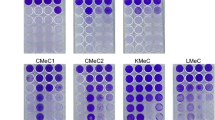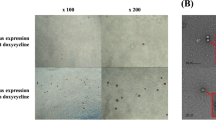Abstract
Background
Canine distemper virus (CDV) has been shown to have oncolytic activity against primary canine tumors. Previous studies from this laboratory had confirmed that CDV induces apoptosis in canine mammary tumor (CMT) cells, although the molecular mechanism remains unknown.
Methods
The CDV N, P, M, F, H, L, C, and V genes were identified in CDV-L and cloned separately. Mutants with deletions in the 5' region (pCMV-F L△60, pCMV-FL△107, and pCMV-FL△114) or with site-directed mutagenesis in the 3' region (pCMV-FLA602-610) of the F gene were generated. Late-stage apoptotic cells were detected by Hoechst 33342. Early-stage apoptotic cells were detected by AnnexinV-FITC/PI. Quantitative real-time PCR was performed to detect the mRNA levels of target genes of apoptotic and NF-κB pathway. Western blot analysis was performed to detect the expression or phosphorylation levels of target proteins of apoptotic or NF-κB pathway. Immunofluorescence assay was performed to detect the nuclear translocation of p65 protein. Recombinant viruses (rCDV-FL△60 and rCDV-FLA602-610) were rescued by a BHK-T7-based system. 5-week-old female BALB/c nude mice were used to detect the oncolytic activity of recombinant viruses.
Results
In this study, it was first confirmed that none of the structural or non-structural proteins of CDV-L, a vaccine strain, was individually able to induce apoptosis in canine mammary tubular adenocarcinoma cells (CIPp) or intraductal papillary carcinoma cells (CMT-7364). However, when CIPp or CMT-7364 cells were co-transfected with glycoprotein fusion (F) and hemagglutinin (H) proteins of CDV-L, nuclear fragmentation was observed and a high proportion of early apoptotic cells were detected, as well as cleaved caspase-3, caspase-8 and poly (ATP ribose) polymerase (PARP). Cleaved caspase-3 and PARP were down-regulated by apoptosis broad-spectrum inhibitor Z–VAD–FMK and caspase-8 pathway inhibitor Z–IETD–FMK, confirming that the F and H proteins coinduced apoptosis in CMT cells via the caspase-8 and caspase-3 pathways. F and H proteins co-induced phosphorylation of p65 and IκBα and nuclear translocation of p65, confirming activation of the NF-κB pathway, inhibition of which down-regulated cleaved caspase-3 and cleaved PARP. Recombinant F protein with enhanced fusion activity and H protein co-induced more cleaved caspase-3 and PARP than parental F protein, while the corresponding recombinant virus exhibited the same properties both in CIPp cells and in a subcutaneous xenograft mouse model.
Conclusions
F and H proteins of CDV-L co-induce apoptosis in CMT cells, while the NF-κB pathway and fusion activity of F protein paly essential roles in the process.







Similar content being viewed by others
Data availability
The datasets generated during and/or analyzed during the current study are available from the corresponding author on reasonable request.
References
Anaya-Eugenio GD, Eggers NA, Ren Y, Rivera-ChÁvez J, Kinghorn AD, Carcache DE, Blanco EJ (2020) Apoptosis Induced by (+)-Betulin Through NF-κB Inhibition in MDA-MB-231 Breast Cancer Cells. Anticancer Res 40(12):6637–6647. https://doi.org/10.21873/anticanres.14688
Clemente M, De Andrés PJ, Peña L, Pérez-Alenza MD (2009) Survival time of dogs with inflammatory mammary cancer treated with palliative therapy alone or palliative therapy plus chemotherapy. Vet Rec 165(3):78–81. https://doi.org/10.1136/vetrec.165.3.78
Egenvall A, Bonnett BN, Ohagen P, Olson P, Hedhammar A, von Euler H (2005) Incidence of and survival after mammary tumors in a population of over 80,000 insured female dogs in Sweden from 1995 to 2002. Prev Vet Med 69(1–2):109–127. https://doi.org/10.1016/j.prevetmed.2005.01.014
Etschmann B, Wilcken B, Stoevesand K, von der Schulenburg A, Sterner-Kock A (2006) Selection of reference genes for quantitative real-time PCR analysis in canine mammary tumors using the GeNorm algorithm. Vet Pathol 43(6):934–942. https://doi.org/10.1354/vp.43-6-934
Gentschev I, Patil SS, Petrov I, Cappello J, Adelfinger M, Szalay AA (2014) Oncolytic virotherapy of canine and feline cancer. Viruses 6(5):2122–2137. https://doi.org/10.3390/v6052122
Goldschmidt M, Peña L, Rasotto R, Zappulli V (2011) Classification and grading of canine mammary tumors. Vet Pathol 48(1):117–131. https://doi.org/10.1177/0300985810393258
Gray M, Meehan J, Martínez-Pérez C, Kay C, Turnbull AK, Morrison LR, Pang LY, Argyle D (2020) Naturally-occurring canine mammary tumors as a translational model for human breast cancer. Front Oncol 10:617. https://doi.org/10.3389/fonc.2020.00617
Guo A, Lu C (2000) Canine distemper virus causes apoptosis of Vero cells. J Vet Med B 47(3):183–190. https://doi.org/10.1046/j.1439-0450.2000.00320.x
Han H, Liu W, Yao X, Yang S, Zou X, Xing Q, Wang P, Zhu W, Luo Y, Jin H, Li F (1998) Isolation and identification of a natural attenuated strain of canine distemper virus and the preparation of its vaccine [in Chinese]. Liaoning J Anim Husb Vet Med 02:7–8
Kaufman HL, Kohlhapp FJ, Zloza A (2015) Oncolytic viruses: a new class of immunotherapy drugs. Nat Rev Drug Discovery 14(9):642–662. https://doi.org/10.1038/nrd4663
Kucharczak J, Simmons MJ, Fan Y, Gélinas C (2003) To be, or not to be: NF-kappaB is the answer–role of Rel/NF-kappaB in the regulation of apoptosis. Oncogene 22(56):8961–8982. https://doi.org/10.1038/sj.onc.1207230
Laine D, Bourhis JM, Longhi S, Flacher M, Cassard L, Canard B, Sautès-Fridman C, Rabourdin-Combe C, Valentin H (2005) Measles virus nucleoprotein induces cell-proliferation arrest and apoptosis through NTAIL-NR and NCORE-FcgammaRIIB1 interactions, respectively. J Gen Virol 86(Pt 6):1771–1784. https://doi.org/10.1099/vir.0.80791-0
Li Z, Wang J, Yuan D, Wang S, Sun J, Yi B, Hou Q, Mao Y, Liu W (2015) A recombinant canine distemper virus expressing a modified rabies virus glycoprotein induces immune responses in mice. Virus Genes 50(3):434–441. https://doi.org/10.1007/s11262-015-1169-x
Li P, Wang J, Chen G, Zhang X, Lin D, Zhou Y, Yu Y, Liu W, Zhang D (2019) Oncolytic activity of canine distemper virus in canine mammary tubular adenocarcinoma cells. Vet Comp Oncol 17(2):174–183. https://doi.org/10.1111/vco.12466
Merlo DF, Rossi L, Pellegrino C, Ceppi M, Cardellino U, Capurro C, Ratto A, Sambucco PL, Sestito V, Tanara G, Bocchini V (2008) Cancer incidence in pet dogs: findings of the animal tumor registry of Genoa, Italy. J Vet Int Med 22(4):976–984. https://doi.org/10.1111/j.1939-1676.2008.0133.x
Mondal M, Guo J, He P, Zhou D (2020) Recent advances of oncolytic virus in cancer therapy. Hum Vaccin Immunother 16(10):2389–2402. https://doi.org/10.1080/21645515.2020.1723363
Novosad CA (2003) Principles of treatment for mammary gland tumors. Clin Tech Small Anim Pract 18(2):107–109. https://doi.org/10.1053/svms.2003.36625
Ou G, Jiang X, Gao A, Li X, Lin Z, Pei S (2022) Celastrol inhibits canine mammary tumor cells by inducing apoptosis via the caspase pathway. Front Vet Sci 8:801407. https://doi.org/10.3389/fvets.2021.801407
Pacifico F, Leonardi A (2006) NF-kappaB in solid tumors. Biochem Pharmacol 72(9):1142–1152. https://doi.org/10.1016/j.bcp.2006.07.032
Plattet P, Cherpillod P, Wiener D, Zipperle L, Vandevelde M, Wittek R, Zurbriggen A (2007) Signal peptide and helical bundle domains of virulent canine distemper virus fusion protein restrict fusogenicity. J Virol 81(20):11413–11425. https://doi.org/10.1128/JVI.01287-07
Rendon-Marin S, da Fontoura Budaszewski R, Canal CW, Ruiz-Saenz J (2019) Tropism and molecular pathogenesis of canine distemper virus. Virol J 16(1):30. https://doi.org/10.1186/s12985-019-1136-6
Sleeckx N, de Rooster H, Veldhuis Kroeze EJ, Van Ginneken C, Van Brantegem L (2011) Canine mammary tumours, an overview. Reprod Domest Anim Zuchthygiene 46(6):1112–1131. https://doi.org/10.1111/j.1439-0531.2011.01816.x
Stern LB, Greenberg M, Gershoni JM, Rozenblatt S (1995) The hemagglutinin envelope protein of canine distemper virus (CDV) confers cell tropism as illustrated by CDV and measles virus complementation analysis. J Virol 69(3):1661–1668. https://doi.org/10.1128/JVI.69.3.1661-1668.1995
Sung H, Ferlay J, Siegel RL, Laversanne M, Soerjomataram I, Jemal A, Bray F (2021) Global Cancer Statistics 2020: GLOBOCAN Estimates of Incidence and Mortality Worldwide for 36 Cancers in 185 Countries. CA Cancer J Clin 71(3):209–249. https://doi.org/10.3322/caac.21660
Uyama R, Nakagawa T, Hong SH, Mochizuki M, Nishimura R, Sasaki N (2006) Establishment of four pairs of canine mammary tumour cell lines derived from primary and metastatic origin and their E-cadherin expression. Vet Comp Oncol 4(2):104–113. https://doi.org/10.1111/j.1476-5810.2006.00098.x
von Messling V, Cattaneo R (2002) Amino-terminal precursor sequence modulates canine distemper virus fusion protein function. J Virol 76(9):4172–4180. https://doi.org/10.1128/jvi.76.9.4172-4180.2002
von Messling V, Zimmer G, Herrler G, Haas L, Cattaneo R (2001) The hemagglutinin of canine distemper virus determines tropism and cytopathogenicity. J Virol 75(14):6418–6427. https://doi.org/10.1128/JVI.75.14.6418-6427.2001
Wang SL, Lee JJ, Liao AT (2016) Comparison of efficacy and toxicity of doxorubicin and mitoxantrone in combination chemotherapy for canine lymphoma. Canadian Vet J La Revue Vet Canadienne 57(3):271–276
Yi C, Liu X, Liu Y, Lu S, Qi Y (2013) Hemagglutinin protein of measles virus induces apoptosis of HeLa cells via both extrinsic and intrinsic pathways. Can J Microbiol 59(12):814–824. https://doi.org/10.1139/cjm-2013-0544
Zhang H, Pei S, Zhou B, Wang H, Du H, Zhang D, Lin D (2018) Establishment and characterization of a new triple-negative canine mammary cancer cell line. Tissue Cell 54:10–19. https://doi.org/10.1016/j.tice.2018.07.003
Acknowledgements
We deeply appreciate Professor Nobuo Sasaki (University of Tokyo, Japan) for the generous gifts of CIPp cells. We deeply appreciate Professor Degui Lin (China Agricultural University, China) for the generous gifts of CMT-7364 cells.
Funding
This work was supported by the National Key Research and Development Program of China (2016YFD0501001).
Author information
Authors and Affiliations
Contributions
All authors contributed to the study conception and design. Material preparation, data collection and analysis were performed by Chenchen Gu, Jun Su and Jigui Wang. The first draft of the manuscript was written by Chenchen Gu and all authors commented on previous versions of the manuscript. All authors read and approved the final manuscript.
Corresponding authors
Ethics declarations
Competing interests
The authors have no relevant financial or non-financial interests to disclose.
Ethics approval
Mouse studies were performed in accordance with the China Agricultural University Institutional Animal Care and Use Committee guidelines (ID: SYXK [Beijing] 2021-0012) and approved by the Animal Ethical and Welfare Committee of China Agricultural University.
Additional information
Publisher's Note
Springer Nature remains neutral with regard to jurisdictional claims in published maps and institutional affiliations.
Rights and permissions
Springer Nature or its licensor (e.g. a society or other partner) holds exclusive rights to this article under a publishing agreement with the author(s) or other rightsholder(s); author self-archiving of the accepted manuscript version of this article is solely governed by the terms of such publishing agreement and applicable law.
About this article
Cite this article
Gu, C., Su, J., Wang, J. et al. Fusion protein and hemagglutinin of canine distemper virus co-induce apoptosis in canine mammary tumor cells. J Cancer Res Clin Oncol 149, 9903–9918 (2023). https://doi.org/10.1007/s00432-023-04878-w
Received:
Accepted:
Published:
Issue Date:
DOI: https://doi.org/10.1007/s00432-023-04878-w




